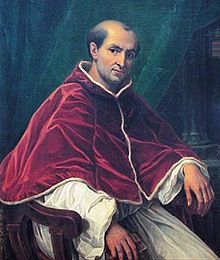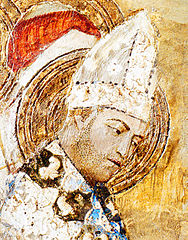 |
| Pope Clement V |
Son of: Beraud de Got, Sire de Villandraut, Grayan, Livran & Uzeste & Ida de Blanquefort.
Clement V's personal & family background.
" . . . Bertrand, the third son of Beraud de Got, lord of Villandraut, Grayan, Livran, and Uzeste, and of Ida de Blanquefort, was born in Villandraut (Gironde) in the middle of the thirteenth century. Theirs was a large family of knightly rank, comprising eleven children, four sons and seven daughters, who in time provided Bertrand with more than twenty nephews. The de Got family was related to the lineages of Mauleon, Fargues, Savignac, and Preyssac, all of whom had strong links with both ecclesiastical and the political establishment in the area. Bertrand's grandfather was the brother of Garcias de Benquet, bishop of Bazas (1166-1179). His uncle, who had the same name, was bishop of Agen (1292-1305). His older brother, Beraud received the archdeaconry of Montaut in Agen in 1279; ten years later, he was appointed archbishop of Lyons (23 July 1289), the last stage before his nomination as cardinal-bishop of Albano (18 September 1294). Another brother, Guillaume Seguin de Got, was papal chaplain and canon of Agen, and by 1297 enjoyed at least seven ecclesiastical benefices." (Clement V: 6-7)
" . . . Bertrand, the third son of Beraud de Got, lord of Villandraut, Grayan, Livran, and Uzeste, and of Ida de Blanquefort, was born in Villandraut (Gironde) in the middle of the thirteenth century. Theirs was a large family of knightly rank, comprising eleven children, four sons and seven daughters, who in time provided Bertrand with more than twenty nephews. The de Got family was related to the lineages of Mauleon, Fargues, Savignac, and Preyssac, all of whom had strong links with both ecclesiastical and the political establishment in the area. Bertrand's grandfather was the brother of Garcias de Benquet, bishop of Bazas (1166-1179). His uncle, who had the same name, was bishop of Agen (1292-1305). His older brother, Beraud received the archdeaconry of Montaut in Agen in 1279; ten years later, he was appointed archbishop of Lyons (23 July 1289), the last stage before his nomination as cardinal-bishop of Albano (18 September 1294). Another brother, Guillaume Seguin de Got, was papal chaplain and canon of Agen, and by 1297 enjoyed at least seven ecclesiastical benefices." (Clement V: 6-7)
His lovers were:
1) Brunissende de Foix, Comtesse de Perigord (1280-1316)
Daughter of: Roger-Bernard III de Foix, Count of Foix & Viscount of Castlebon & Margarita de Moncada.
Wife of: Helie VII de Perigord (1250-1311), mar 1298.
A perfect prototype of Pope Alexander VI?.
" . . . Clement V, on the contrary, officially the sworn protector of the Order, only aided in its destruction through infamous avarice and wretched cowardice. In truth, how could a feeling for justice and honour, a spark of moral courage, be expected from a man who stands in the history of the 'Cathedra Petri' a perfect prototype of Alexander VI?---from a Pope, whose unbridled behaviour at Avignon, Poitiers, and Bordeaux, even in that not ever-delicate age, disgusted every not utterly corrupt observer?---from a Pope who, according to the testimony of one of the best educated and most honourable princes of the mediaeval Church, Archbishop Antonine of Florence, lived quite openly with his 'lady-friend,' the charming Brunissente, daughter of the Count de Foix and wife of Count de Talleyrand-Perigord---so openly that his Holiness's lady-friend did not hesitate to break the handsomest diamonds out of the papal tiara, and have them set in her bracelets?. . . ." (The New Monthly Magazine, Volume 134: 225)
A life of royal sensuality in the papal palace at Avignon.
"The crushing of the Order of the Templars is one of the grossest single exploits of the Inquisition. The king of France wanted their wealth, and, as Vacandard himself candidly says, the Pope "truckled" to him. This was Clement V, the one Pope in whom, up to the present, I have had to note some semblance of humanity. From the time he had bought the tiara, with the connivance of the French king, and his name is the one most frequently quoted by apologists when they would illustrate the liberality of the Popes, I may add that he lived a life of royal sensuality in the Papal palace at Avignon and is more than suspected of tender relations with the Countess de Talleyrand-Perigord. He died worth more than $2,500,000. This was the good Pope, the humane Pope, who permitted the Templars to be robbed and murdered after one of the grossest travesties of a trial in history. Large numbers of the Knights died under the fearful torture rather than lie about their own Order." (McCabe)
The Pope is a public fornicator.
" . . . Clement V was described as 'a public fornicator and kept for his leman [lover] the Countess Perigord, the most beautiful lady and daughter of Earl Foix. Petitioners who sought the Pope's blessing had to lay their requests on the 'silky white bosom of Countess Perigord.'" (A Corrupt Tree: 180)
Papal capital relocation due to his love for a beautiful woman. "Among the many reasons which had induced Bertrand de Goth, as Pope Clement V, to transfer the Papal residence to Avignon was his love for the beautiful Comtesse de Perigord, daughter of the Comte de Foix...." (Rappoport: 148)
A most beautiful lady.
" . . . Some chroniclers accused the pope of simony, avarice, nepotism, and even intimate relations with Brunissende, the countess of Perigord, 'a most beautiful lady, daughter of the count of Foix. . . " (Clement V: 21)
A very beautiful woman.
The Pope is a public fornicator.
" . . . Clement V was described as 'a public fornicator and kept for his leman [lover] the Countess Perigord, the most beautiful lady and daughter of Earl Foix. Petitioners who sought the Pope's blessing had to lay their requests on the 'silky white bosom of Countess Perigord.'" (A Corrupt Tree: 180)
Papal capital relocation due to his love for a beautiful woman. "Among the many reasons which had induced Bertrand de Goth, as Pope Clement V, to transfer the Papal residence to Avignon was his love for the beautiful Comtesse de Perigord, daughter of the Comte de Foix...." (Rappoport: 148)
A most beautiful lady.
" . . . Some chroniclers accused the pope of simony, avarice, nepotism, and even intimate relations with Brunissende, the countess of Perigord, 'a most beautiful lady, daughter of the count of Foix. . . " (Clement V: 21)
A very beautiful woman.
"Pope Clement V died A.D. 1314, near Avignon, leaving behind him this character, according to your historian: 'He loved money greatly, so that at his court all benefices were sold. It was publicly said that he had for his mistress the Countess of Perigord, a very beautiful woman, daughter of the Count de Foix, and he left immense treasures to his nephews and other relations.'..." (Hopkins & Kenrick, 1856, p. 150)
2) Cecile.
"One of the contemporaries of Pope Clement V (1306-1314) wrote of him: 'He was a whore-monger and a patron of whores [who] removed the Papal See to Avignon that he might see perpetrate his wickedness with greater privacy.' The names of at least three of his mistresses were: the Countess of Turenne, Perigord, the daughter of the Comte de Foix, and one known only as Cecile." (Penn, 2007, pp. 265-266)
 |
| Pope Clement VI @Wikipedia |
(1291-1352)
His lover was:
Cecile de Comminges (1320-1384)
Countess of Turenne
"Pope Clement VI (1342-1352) frequently entertained the beautiful Countess Cecile of Tonnerre in his palace in Avignon. He was also known for being naked with his many mistresses between sheets lined with ermine. When his confessor encouraged him to live chastely, he claimed he slept with women on the advice of doctors." (Dogma Evolution & Papal Fallacies: 266)
"While most papal mistresses stayed quietly in the background, there were a few exceptions. The charming Cecile, countess of Turenne, believed to be the mistress of Pope Clement VI (reigned 1342-1352), evidently did the same things that Olimpia would do three hundred years later and received the same criticism. The scintillating countess sold offices, received bribes for her influence, and paraded around with great haughtiness."(Mistress of the Vatican: 176)
The most notorious Olympia in history was Olympia Maldachini Pamphili, widowed sister-in-law and openly acknowledged mistress of Pope Innocent X, over whom she exercised ruled power. This Olympia may have held a special interest for Manet, since Velazquez painted her in 1649 during his stay in Rome when he painted his famous portrait of Innocent X. In Manet's day such historical trivia were better known than they are today." (Edouard Manet: Rebel in a Frock Coat)
No comments:
Post a Comment